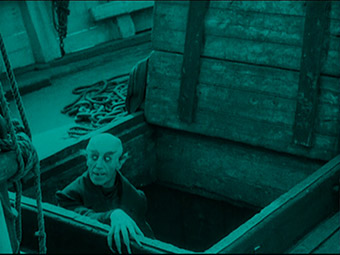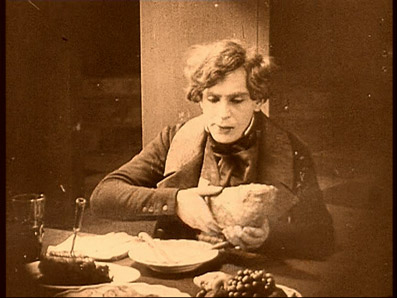|
Can there be four more sinister syllables in horror fiction than 'Nos-fer-a-tu'? The name Dracula may have a demonic ring, but also has a grandeur and romanticism furnished by the Count's aristocratic status and historical lineage. But Nosferatu is word that, if pronounced correctly, is impossible to make sound pleasant, a word that almost demands to be hissed rather than spoken. Listen to how the ageing Cuda employs it to accuse his young cousin in George Romero's masterful modern vampire tale Martin, where it becomes both a verbal spit of disgust and an accusation shrouded in fear.
And so it should be. The origins of the term are a matter of speculation, but its use in Bram Stoker's genre-defining novel Dracula ensured its future legitimacy as a darkly suggestive term for the undead. It also provided the great German filmmaker F.W. Murnau with an evocative title for his own, unofficial film version of Stoker's novel, and was one of many cosmetic changes designed, no doubt, to avoid the very copyright problems that eventually saw almost every print of the film destroyed. The crucial word here is 'almost' – we can only be thankful that the recall was not absolute. And there has, in recent years, been more to be thankful for when discussing the first and yet greatest of all vampire movies. This new DVD from Masters of Cinema is definitely one of them.

But first, the film. It's one I have a long history with and one of a small handful of films that first sparked my fascination with the vampire genre. Make no mistake, this is not just a sub-genre of the horror movie but a genre in its own right, with its own specific codes and conventions and unique iconography. By virtue of its timing and phenomenal popularity, Universal's Dracula may well have been the film that launched the vampire genre, but it still owes a debt to Murnau, and in later years, when Lugosi's Count had become the stuff of parody, filmmakers would increasingly look back to the genre's true cinematic origins for inspiration.
Nosferatu has been written about by many over the years, myself included. It's a fascinating, haunting, beautifully realised giant of the silent era and a key work of German expressionist cinema. If you're new to the film or want to read a bit about it – well, quite a bit, actually – before I talk about this new DVD release, then you can read my comparison review of the past Eureka and BFI DVD releases by following this link.
This new 2-disc set from Eureka is no redressed re-release but a considerable upgrade on the previous version, with a restored and remastered picture, the first ever recording of the original music score, a new commentary and documentary, and an authoritative collection of essays on the film and its director. So let's start with…
In my previous review I gave legitimate reasons why expectations for an even close to pristine picture were unrealistic, with the age of the film, coupled with the loss of the negative and most of the prints, presenting a Herculean task for anyone looking to restore the film to its former glory. The previous releases from Eureka and the BFI reflected this – the prints were riddled with dust, scratches and damage, almost constant picture instability and jitter, and an exposure that could vary from frame to frame. The Eureka DVD contained two versions of the film, one monochrome, one sepia tinted, neither of which were true to the original tinting process, although the monochrome print did score over any of the tinted versions in picture detail. The BFI transfer restored the original tinting, but a little sharpness was lost in the process.
This new digital restoration was carried out by F.W. Murnau-Stiftung in Germany and is, for those of us who know the film from its previous releases, a revelation. The picture has been stabilised, exposure variations severely reduced, a huge amount of damage has been repaired and digitally removed, and even some of the more drastic scratches have been very effectively minimised. Some of the damage is still present and visible, but has been effectively knocked back so that it no longer dominates or detracts from the image.
The frame grabs below give some idea of the astonishing result of this digital clean-up, but only some – they can't show the massively improved picture sabilisation and exposure consistency. The upper images are taken from the previous Eureka release, while the ones below are from the new remastered print.
The original tinting has been reproduced, but the strong night blues of the BFI print have been reduced to a more subtle shade, resulting in improved picture sharpness and especially shadow detail. The bit rate, when intermittently checked, was always very high – I'll wager that this is as good as the film has looked since it's release and frankly better than I ever expected to see. But there's more.
Just about every release of the film on any home video format has been accompanied by a different score, some more appropriate and effective than others. Gérard Hourbette and Thierry Zaboitzeff's electronic track on the previous Eureka release certainly had its moments, particularly when suggesting the sinister aspect of Hutter's early encounters with Orlock, but lost it a bit with the introduction of more avant-garde elements in the later scenes. The BFI disc boasted a newly commissioned score by James Bernard, whose music for Hammer's version of Dracula is as much part of the film's identity as its lead performers and its bright red blood. Although more appropriately orchestral and dramatic, it's similarities to his Dracula score – complete with a main theme that spells out the title – ended up aligning Nosferatu with a series of films that it is stylistically otherwise distanced from.
The score included on the Masters of Cinema release is, for the first time on any modern release of the film, the one that accompanied the original screenings in Germany in 1922. Composed by Hans Erdmann and only previously ever performed live, the score was recorded for this release by the Radio Symphony Orchestra Saarbrücken and conducted by Berndt Heller. This is not just a historical curio but a full blooded symphonic piece that compliments the film's gothic beauty well and matches the mood set by the visuals at every step, though does occasionally plump for a sense of adventure on scenes that cry out for dread. The quality of the recording is excellent, as you'd expect, and can also be played in room-filling 5.1 surround.
Commentary by Brad Stevens and R. Dixon Smith
A useful gathering together of information on Nosferatu and the readings of its meanings, though one whose prime appeal will be for newcomers to the film and the various writings on it. Indeed, a fair amount of the points discussed here you'll also find covered in my review of the earlier DVD releases – I'd like to claim that this was an influence on the commentary content, but the points made are almost all either well known or self-evident to those who have studied the film in any depth. One remark here that I will respond to, but can't take credit for, is the commentators' bemusement at the presence of what appear to be the crosses of graves on the shoreline, something a good friend of mine rationalised as being markers for local men who had died at sea.
The Language of Shadows: Friedrich Wilhelm Murnau and His Films (52:38)
A documentary specially made for F.W. Murnau-Stiftung by Luciano Berriattúa, one that gives the impression of being the first of a series on the director, covering Murnau's youth and early films before concentrating exclusively on Nosferatu. The childhood information and interviews with relatives of Murnau and his associates initially suggests a standard biographical piece, but this soon gives way to some revealing detail on the director's early 'lost' films, which are accompanied by stills and clippings and a rare surviving clip of his second film Satanas, whose unabashed eroticism is, to say the least, intriguing. But the hook really bites once we get onto Nosferatu, particularly the tour of locations used for the film, many of which have changed surprisingly little in the intervening years. Those who have the original Eureka disc may remember the extra feature there titled Nosferatu Recaptured, which took us on a similar trip round the locations, but they are covered here in considerably more detail and on video rather than as a series of stills.

Restoration Demonstration (3:15)
An informative look at the process of restoring the film to its present fine condition, complete with the sort of before-and-after comparisons that demonstrate the improvements far better than any frame grabs can. As a bit of a techie I could have done with more detail on the different stages of the process, but for most this will prove just right.
Booklet
The 96-page booklet is one of MoC's best and contains a revised and in-depth 2001 analysis of the film by Thomas Elsaesser, an even more detailed 1998 essay by Gilberto Perez, a newly translated 1921 piece by Nosferatu producer and designer Albin Grau on vampires, a brief sizeable extracts from an article detailing an earlier restoration by Enno Patalas, brief notes on the current digital restoration, and a short essay by Craig Keller. All make for intriguing reading, although the depth of analysis of the first two essays may leave some wondering if the writers aren't reading more into the film than is actually there, but this is a film so rich with subtextual suggestion and meaning that such readings are both inevitable and valid.
This is an easy sell. The greatest of all vampire movies looking better than you've ever seen it with the best music score of any DVD incarnation, a first-rate documentary extra and a superb accompanying booklet. If you've been thinking about getting the film on DVD but have never got round to it then the time really has arrived, and even if you own one (or both) of the earlier releases then consider this an essential upgrade. Highly recommended.
|
